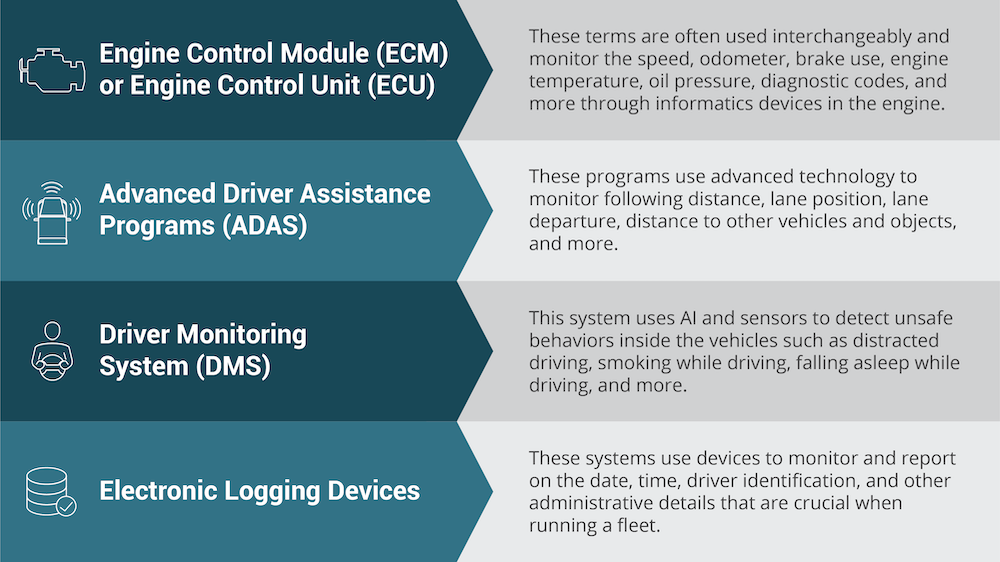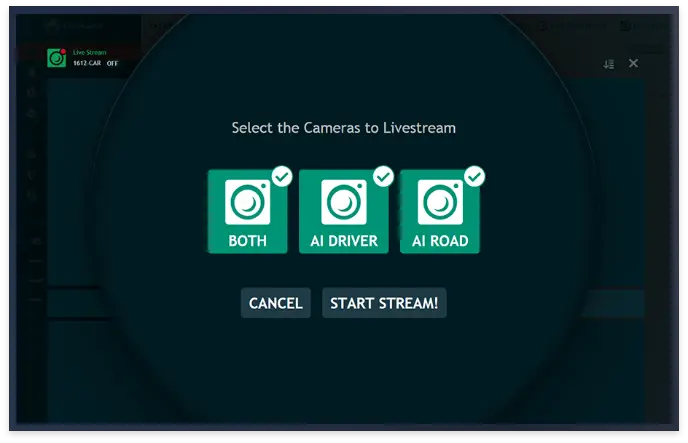Video Telematics System for Fleet Vehicles
Telematics describes the system of technologies that collects data about vehicle use and transmits that data to fleet management systems. From there, fleet managers can use the information to better monitor fleet performance and activity. Telematics solutions can help improve the entire fleet management strategy and each aspect of vehicle monitoring.
How Telematics Works

A telematics system requires three components: a vehicle tracking device, cellular connectivity, and a desktop or mobile app interface. Here’s how it works:
- The vehicle tracking device will record information from the fleet vehicle
- This data is then transmitted typically via a cellular network
- The vehicle information updates are displayed in near real-time on a desktop computer or mobile app interface where fleet managers can review it
There are two main versions of telematics: your traditional telematics systems and then your video telematics systems. Video telematics is a new form of telematics that uses video cameras to capture vehicle information and location the same where a traditional telematics divide would. In both of these telematics systems, there are several different parts that can record information beyond simply the location of a vehicle. These are some of the most common features used today:

No matter the type of system or its features, the information from the vehicles is transmitted to a server typically via cellular connectivity and then to a desktop computer or mobile app where fleet managers can use it to monitor fleets and make better-informed decisions.
The History of Telematics
Telematics comes from the blending of two industries. One industry is telecommunications, which is the process of exchanging information using technology. The other is informatics, which uses computer systems to gather, analyze, and manage real-world information and databases.
These two industries merged in the 1960s when the Department of Defense developed GPS tracking for US assets and US military communication efficiency. The development of GPS was the first instance where computer informatics was combined with telecommunications, which laid the foundation for telematics. After the invention of the internet and machine-to-machine (M2M) communication, GPS telematics could be created. The term telematics was first used in 1978, and the systems evolved as GPS technology improved. The most recent upgrade in telematics accuracy happened in 2005 when the US military improved GPS by launching the first modernized GPS satellite.
Benefits of Telematics
Telematics solutions can help keep track of a fleet overall as well as the little details that keep a fleet running smoothly. These are some of the main benefits of a telematics system:
- Productivity. Telematics improves dispatching and routing vehicles. In turn, this also improves customer satisfaction as vehicles arrive in the right location with more efficient timing. Telematics also helps drivers avoid traffic delays and to plan routes for bad weather. Those monitoring the system can also help steer drivers on the most efficient routes to keep the fleets at their most productive with happy customers.
- Safety. One of the most important focuses of any fleet management system is the safety of the drivers. Telematics provides real-time feedback to drivers about speeding and braking, which improves driving behavior and safety. Fleet managers can use the data to create training programs that improve driving habits and the fleet’s overall safety. In addition, telematics can provide information on collisions and even help locate a stolen vehicle.
- Optimization. Telematics helps streamline the process of fleet management by tracking high fuel usage habits, like idling, and other remote maintenance data to optimize the usage of fuel and the fleet as a whole.
- Compliance. Fleets must meet compliance requirements for ELD, IFTA reporting, vehicle inspections, and sometimes more. Telematics can make it easier to maintain compliance with these regulations because it’ll track information like driver hours of service and provide a daily record of all the fleet’s information. It’s much easier to meet the requirements of laws when fleet managers can easily view all of the data.
- Integration. Once a basic telematics system is in place in a vehicle, it’s much easier to integrate additional fleet monitoring technology, like video cameras, CRM software, and other applications.
- Sustainability. Telematics systems can identify where waste is happening with fuel usage, spillage, etc., and help managers to make adjustments that help the environment and keep companies more sustainable.
- Visibility. One of the main purposes of telematics is to allow fleet managers to see exactly where every vehicle is at the moment. This beneficial visibility can also be used to track trailers and other asset equipment in your fleet.
- Maintenance. Telematics systems pull data straight from the vehicles to help fleet managers schedule and set up regular maintenance for the fleet. Telematics also identifies faults that can help managers plan when a vehicle needs to be taken into the shop.
- Vehicle Health. Telematics can identify when something goes wrong in the vehicle and helps fleet managers plan while reducing unplanned downtime for vehicles. By regularly maintaining and repairing vehicles, the overall health of the vehicle will increase.
- Cost. Telematics can save fleet managers money. As vehicles are maintained and last longer, managers won’t need to replace vehicles as often. On a day-to-day basis, telematics can help keep fuel costs down by identifying those areas of idling and waste.
- Enhanced Service. Vehicles that are where they need to be will increase customer satisfaction and a company’s overall reputation and service.
Telematics in Fleet Management
Telematics is the basis of nearly every fleet management system. Without devices in the vehicles transmitting data, it would be impossible to monitor a fleet with the same level of accuracy. Telematics gives fleet managers valuable information about driver behavior, safety, weather, road conditions, vehicle health, and more that help them monitor a fleet and provide the right training and maintenance.
Many industries are turning to telematics for fleet management. Here are just some of the industries using telematics fleet tracking:
- Delivery companies
- Towing companies
- Trucking companies
- Government agencies
- Construction businesses
- Food and beverage companies
- Oil, gas, and mining industries
- Police, first responders, and other public agencies
- Landscaping companies
- Waste management fleets
- Car rental and leasing companies
The Future of Telematics Solutions
Telematics will continue to grow and evolve as technology does. GPS will continue to improve and with it, telematics will improve as well. Future telematics systems may implement more modern GPS technology, especially through the use of mobile phones and video cameras. In addition, data is key to telematics, but it can be difficult to put data into action. Future telematics technology will make applying data to the real world easier. Lastly, with the introduction of the 5G network, fleet telematics is seeing a shift from outdated 2G, 3G connections to a faster 5G connectivity for its devices.
Telematics will continue to shift and implement new technologies. Fleetcam provides some of the most advanced fleet tracking telematics technology currently available. Fleetcam’s telematics fleet tracking system provides all the benefits of telematics along with those of high-quality fleet management. As GPS improves and telematics evolves, Fleetcam will be right there along with it, helping move technology forward. To see how Fleetcam telematics works for yourself, request a demo today.









